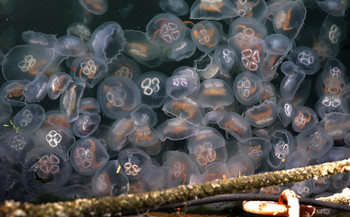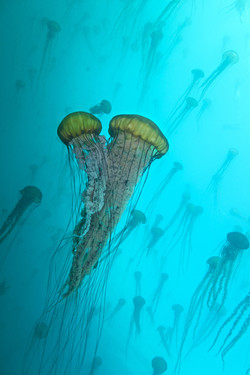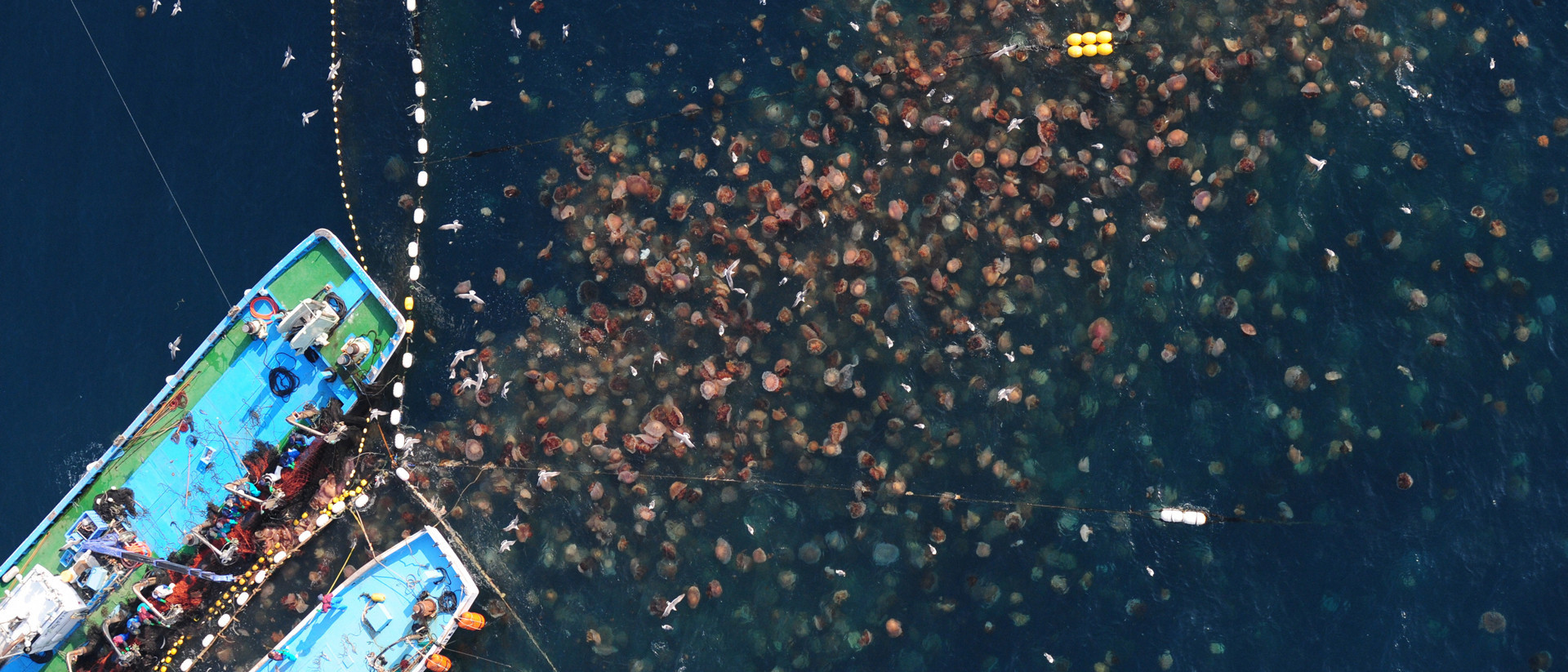Why did the scientist cable-tie dead jellyfish to a platform and send them to the bottom of a Norwegian fjord?
Answer: He wanted to see if anything would eat them.
This is the very latest in jellyfish research. In other words, we don’t know squat. For a long time, that was fine. But then huge invading swarms – jellyfish blooms – appeared out of nowhere and started making the news. Nobody knows where they come from, or how to get rid of them once they’ve arrived.
Moon jellies (Aurelia aurita). Photo from Hollandse Hoogte

These millions of densely-packed swimming sacks of slime are capable of spectacular acts. My personal favorite: the time they shut down “America’s flagship,” the nuclear-powered aircraft carrier USS Ronald Reagan. The reactor’s cooling system had swallowed too many jellyfish along with its water intake.
Any machine that imbibes seawater risks problems with jellyfish blooms. The creatures have repeatedly paralyzed everything from power station cooling systems and data centers to simple water treatment plants, leaving countless people around the world – from India to Sweden, from the Philippines to Israel and California – without electricity or water for days. In some places, locals even assumed a coup was underway. Because who thinks of jellyfish?
Jellyfish: coming this summer to a sea near you
Jellyfish are a hassle for tourists, too. Former British Prime Minister David Cameron got stung on vacation in Lanzarote. He should’ve gone swimming behind an anti-jellyfish net, or worn an anti-jellyfish bathing suit, or used anti-jellyfish sunscreen. Yes, these things exist.
What worries scientists most is that jellyfish hordes suck the life out of every sea they meet
What makes for less spectacular news but worries scientists most is that jellyfish hordes suck the life out of every sea they meet.
Once a bloom gets its tentacles through their nets, open-ocean fisheries may as well shut up shop. And when tons of jellyfish strike a fishing boat’s net, their sheer weight can capsize the vessel; this happens in Japan from time to time. But it’s wild fish that suffer most. Jellyfish eat fish larvae as well as the plankton they live on, further damaging already depleted stocks.
Jellyfish could hit fish supplies hard – and economies perhaps even harder. South Korean scientists estimated jellyfish were costing their country $ 70 to $ 200 million a year in fish-related revenue losses. A handful of South Korean roboticists decided enough was enough: it was time to take action. And so our first curious anti-jellyfish solution – JEROS, the jellyfish terminator – was born.
Solution 1: Destroy them with special Korean shredders
This Jellyfish Elimination Robotic Swarm isn’t a single Schwarzenegger but a fully automated fleet of them. Above water, each one resembles a mini-giraffe riding atop a five-foot-square catamaran.
Illustrations by our Editorial Designer Leon Postma

How does the thing work? When the camera at the end of the long neck spots an object, algorithms calculate whether it’s a jellyfish, based on shape. If there’s a match, JEROS summons the rest of the fleet, and other algorithms calculate the optimum path of destruction. The terminator units sail forth, driving the jellyfish into underwater traps that end in whirling blades. And it’s game over for 25 jellies a minute per raft.
But not all jellyfish are created equal. South Korea struggles with moon jellies (Aurelia aurita). This species has a four-leaf clover shape visible through its bell and a diameter of approximately 15 inches. Also troublesome is Nemopilema nomurai, a bulky orange variety that, at a diameter of some six feet, can weigh up to 450 pounds. JEROS in its current form is no match for this monster, which can sink fishing boats and break nets: its traps are too small. So the Koreans’ algorithms only recognize moon jellyfish as the enemy. But that’s about to change.
“A lot of international companies are interested in optimizing JEROS for different environments and jellyfish species,” says its creator, Hyun Myung, a roboticist at the Korea Advanced Institute of Science and Technology. He’s been getting plenty of email from the Middle Eastern offshore industry, he says. “It’s hard to set up individual algorithms for every species of jellyfish, so we’re working to equip JEROS with artificial intelligence, or machine learning algorithms.” Soon, JEROS should be able to teach itself to identify jellyfish. Politics is about to get interesting.
...Then again, maybe not
The surge of international interest in JEROS has been accompanied by a surge of commentary. Jellyfish experts say the shredders do more harm than good. They see two major problems.
First, where do the shreds end up? There are several possibilities. They could sink to the ocean floor and rot away, smothering life there in slime. After all, what eats jellyfish? And anything that does probably can’t eat as fast as JEROS can shred. Or the sticky mass could gunk up cooling systems, just as whole jellyfish do, except the tiny pieces are even harder to get rid of. Or tentacle fragments studded with stinging cells could wash over anti-jellyfish nets and beaches, effectively expanding the creatures’ reach.
The second problem is that when you cut jellyfish open, they release all their eggs and sperm at once. The cells fertilize each other. And next season, your jellyfish bloom is exponentially worse.
“We’ve rethought the shredder,” Myung says. A new version of JEROS scoops jellyfish out of the water and into a storage container that holds 420 animals.
Illustration by Leon Postma

But what do you do with the creatures once you’ve caught them? It’s not like all jellyfish are edible. “We’re wondering the same thing,” Myung says. “I saw a paper recently that proposed using jellyfish as fertilizer in rice farming.”
The paper’s authors say the method would increase harvests while obviating the need for chemical weed killers. It’s an incredible story – autonomous swarms of jellyfish-busters making fertilizer for Korean rice farmers. “It sounds good,” Myung says. “And maybe the cosmetic industry can do something with jellyfish. They’re rich in collagen.” Medusa brand wrinkle cream, anyone?
Solution 2: Control them using a Russian-German hormone treatment
A viable jellyfish fertilizer industry would depend on JEROS delivering a steady supply of the creatures. While jellies are common, blooms’ sizes and times of appearance vary widely. You can’t base a business plan on that. Not unless you could control the appearance of blooms. Well, it turns out you can. Which brings us to curious anti-jellyfish solution number two, from the jellyfish whisperer of St. Petersburg.
At the Zoological Institute at Germany’s Kiel University, Russian molecular biologist Konstantin Khalturin discovered a substance that makes moon jellyfish (Aurelia aurita) pump out babies within 48 hours. “It’s not birth control, it’s uncontrolled birth!” the scientist says.
To understand how Khalturin’s birth pill works, you need to know about the jellyfish’s singular reproductive rituals. “That transparent, pulsating disc we all think of as a jellyfish – that’s just a phase, one of its three manifestations,” Khalturin says. The animal’s genome basically contains three blueprints: larva, polyp, and jellyfish.
Blueprint 1: The larva. Jellyfish larvae swim around in the ocean for a while until they find a nice hard rock, fasten themselves to it, and transform into polyps.
Illustration by our editorial designer Leon Postma


Blueprint 2: The polyp. Jellyfish polyps can endlessly reproduce asexually – in other words, clone themselves. When sexual reproduction becomes necessary for fresh DNA, a polyp makes jellyfish. It does so by dividing the end of its body into horizontal discs and shooting them off into the endless blue, in a process called strobilation. The discs – or ephyra – take in water until they’re 96% made up of it. Voilà: full-fledged jellyfish.
Illustration by our editorial designer Leon Postma


Blueprint 3: The jellyfish. These elegant pulsating discs represent the medusa stage, in which jellyfish produce eggs and sperm. The animals fertilize each other and create larvae, bringing us back to Blueprint 1.
Illustration by our editorial designer Leon Postma


“Isn’t it bizarre?” Khalturin crows. “The same DNA can make a creature that crosses oceans, wipes out fish, clogs up power plants, and lives six months at most – and then make a polyp that’s completely stationary but can live passively for a really long time. Some polyps are actually biologically immortal.”
Metamorphic hormones FTW?
Khalturin’s birth pill forces moon jelly polyps to strobilate, or make discs. Dump 150 kilograms of the active ingredient in a cubic kilometer of water and all the polyps living there will make mini-jellies. It sounds perfect: in theory, you could time blooms to coincide with the arrival of the JEROS jellyfish-busters. “Or you could cause new jellyfish generations to die prematurely, if necessary,” Khalturin says, “by making the polyps bloom in the winter, when there’s not enough food in the sea for baby jellyfish.”
Sea nettles (Chrysaora fuscescens). Photo from Getty

Here, too, practical difficulties separate the dream from the reality. Even if you could dump hormones in the sea by the pound without harming other life forms – and we don’t know if you can – good luck finding those jellyfish bloom polyps in an immeasurably vast ocean in the first place.
What makes it so hard? Polyps are nearly invisible. On solid bases, they form semitransparent carpets that are mere millimeters high. Even if you found some, you’d immediately face a new problem: we don’t even know which species many polyps belong to. And it’s almost impossible to figure out. Thanks to currents, a jellyfish can drift miles away from the polyp that birthed it before we spot it.
Maybe we first need to get a handle on some basics. Which jellyfish are found where, and when? That’s exactly what Italian expert Ferdinando Boero has been interested in for years.
Solution 3: Surveil them with apps
“Fight jellyfish?” Boero says when I speak with him on Skype. “Forget it.” Any tactic you’d use to combat any other plague is useless against jellyfish. Pesticides don’t affect them. Many species don’t actively swim in any particular direction, so you can’t chase them away. Electrocution doesn’t work. Acoustic shocks? Nope: with no brain or ears, a jellyfish has no notion of sound. “Jellyfish shredders, hormones – you’re just treating the symptoms,” Boero says.
“Eat a jellyfish? Why would you do that? It’s 96% water. You might as well swim with your mouth open”
And it’s probably not wise to randomly pull jellyfish out of the sea anyway, or otherwise declare war. “Who knows what food shortage you’d be causing for sea creatures somewhere else?” Boero says.
Deep-sea ecologist Andrew Sweetman – the man who sinks jellyfish to the bottoms of fjords – has found that various fish and crustaceans do eat them. This result confounded him. “Eat a jellyfish? Why would you do that? A jellyfish is 96% water. You might as well just swim with your mouth open.” Apparently, they’re the green tea of the sea. “And everything that normally eats jellyfish,” Boero says, “is now for sale at the grocery store. It’s simple: restore fish stocks and you’ve solved your jellyfish problem.”
Boero is a big proponent of citizen science. In a bid to increase marine literacy, he aims to get everyone around the Mediterranean excited about jellies. In 2009, he started the project Occhio alla Medusa – ‘Spot the Jellyfish’ – for which he made a poster showing all the known species found in the region and asking people to report sightings using apps like JellyWatch or by email.
Landing jellyfish in Ban Talae Nok, Thailand. Photo from Hollandse Hoogte

“With the help of citizen information, we’ve already been able to identify broad patterns in the frequency of occurrence of barrel jellyfish, Rhizostoma pulmo, and fried egg jellyfish, Cotylorhiza tuberculata,” Boero says. For example, in mid-July, C. tuberculata suddenly shows up everywhere along more than 5000 miles of the Italian coastline.
Could the data eventually be used to write a program to predict jellyfish blooms, as meteorologists do the weather? “People expect science to produce algorithms that with one click can predict the future,” Boero says. “This is an infantile expectation.” It’s hard enough to guess what the weather will be like the day after tomorrow. Jellyfish blooms depend on many more variables. “We can’t do much more than make soft predictions,” Boero says.
Others dispute that, however. Many jellyfish species don’t actively determine their swimming direction; ocean currents do it for them. And we know how to model those currents. Admittedly, we still don’t know why particular polyps in a given location start making jellyfish. Exactly how a bloom starts remains unclear.
“But we’re still discovering new species,” Boero says, “thanks to people sending in pictures of jellyfish that aren’t on the poster. People are always surprised when you tell them there are probably about 8 million animal species living on earth and we know about fewer than 2 million of them.”
Despite the importance governments and bodies like the United Nations attach to biodiversity, such knowledge gaps are typical. “We’re finding black holes in every corner of the universe,” Boero says. “That kind of research costs billions of euros. And yet what impact do we have on black holes? And what impact do black holes have on our well-being?”
First, let’s investigate the black holes in our understanding of marine ecosystems, before the seas turn to jellyfish soup. Then we can simply forego all the non-solutions.
A moon jelly swarm in Denmark. Photo by Casper Tybjerg

—Translated from Dutch by Laura Martz and Erica Moore
More stories from De Correspondent:
 This is what goes wrong inside your head every day
Thanks to our ability to grasp objects and to grasp language – tasks at which our left brain excels – we humans rule the planet. But why do things sometimes go so absurdly wrong? A cautionary tale of what gets skewed within our skulls and what we can do about it.
This is what goes wrong inside your head every day
Thanks to our ability to grasp objects and to grasp language – tasks at which our left brain excels – we humans rule the planet. But why do things sometimes go so absurdly wrong? A cautionary tale of what gets skewed within our skulls and what we can do about it.
 Why we know less about developing countries than we think
Africa boasts five of the world’s ten fastest-growing economies. And the percentage of poor and malnourished people worldwide has been cut by half in the last 25 years. Poor countries seem to be prospering – but is the rosy picture accurate? We crunched the numbers, and here’s the truth: when it comes to developing countries, there’s a lot we don’t know.
Why we know less about developing countries than we think
Africa boasts five of the world’s ten fastest-growing economies. And the percentage of poor and malnourished people worldwide has been cut by half in the last 25 years. Poor countries seem to be prospering – but is the rosy picture accurate? We crunched the numbers, and here’s the truth: when it comes to developing countries, there’s a lot we don’t know.




